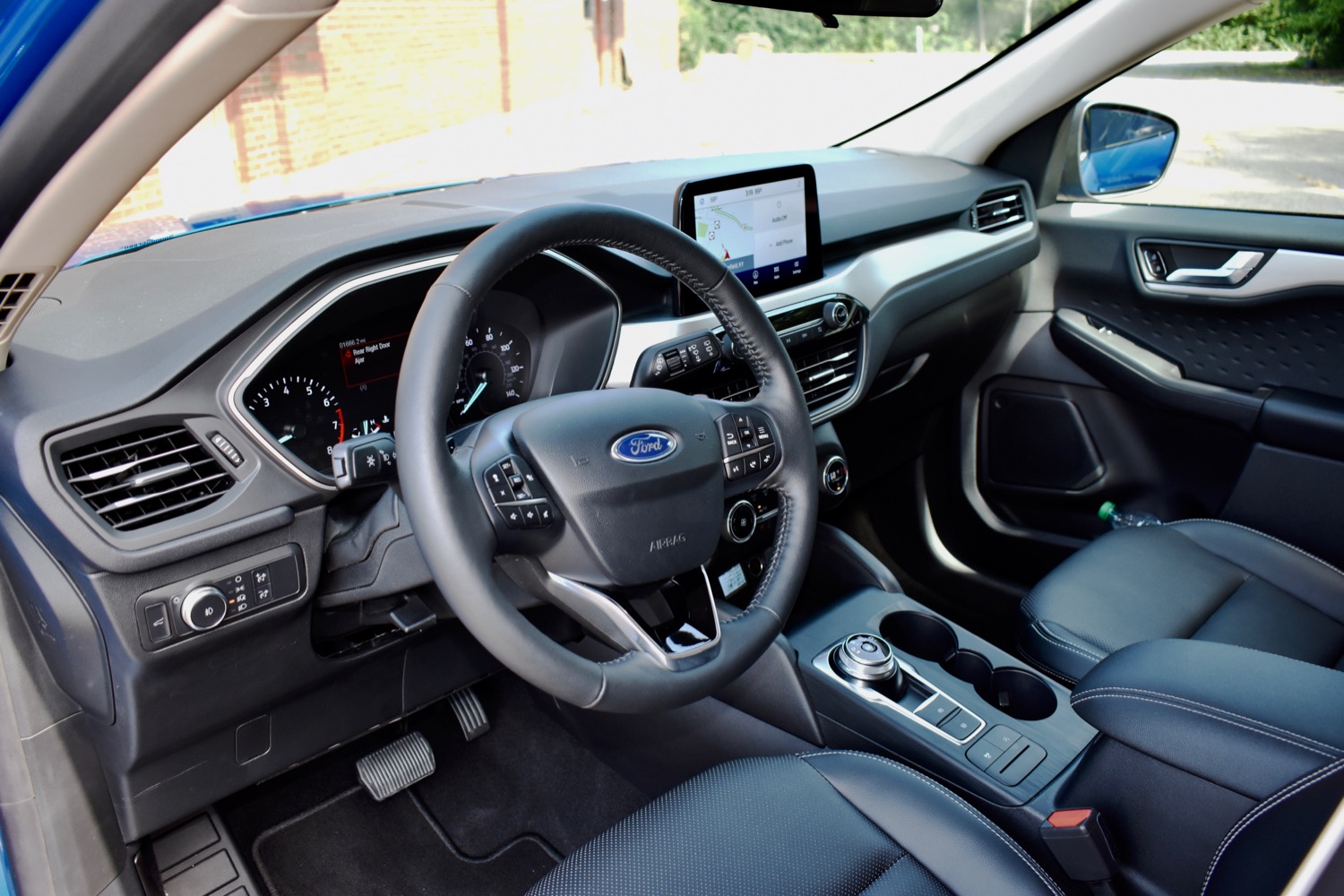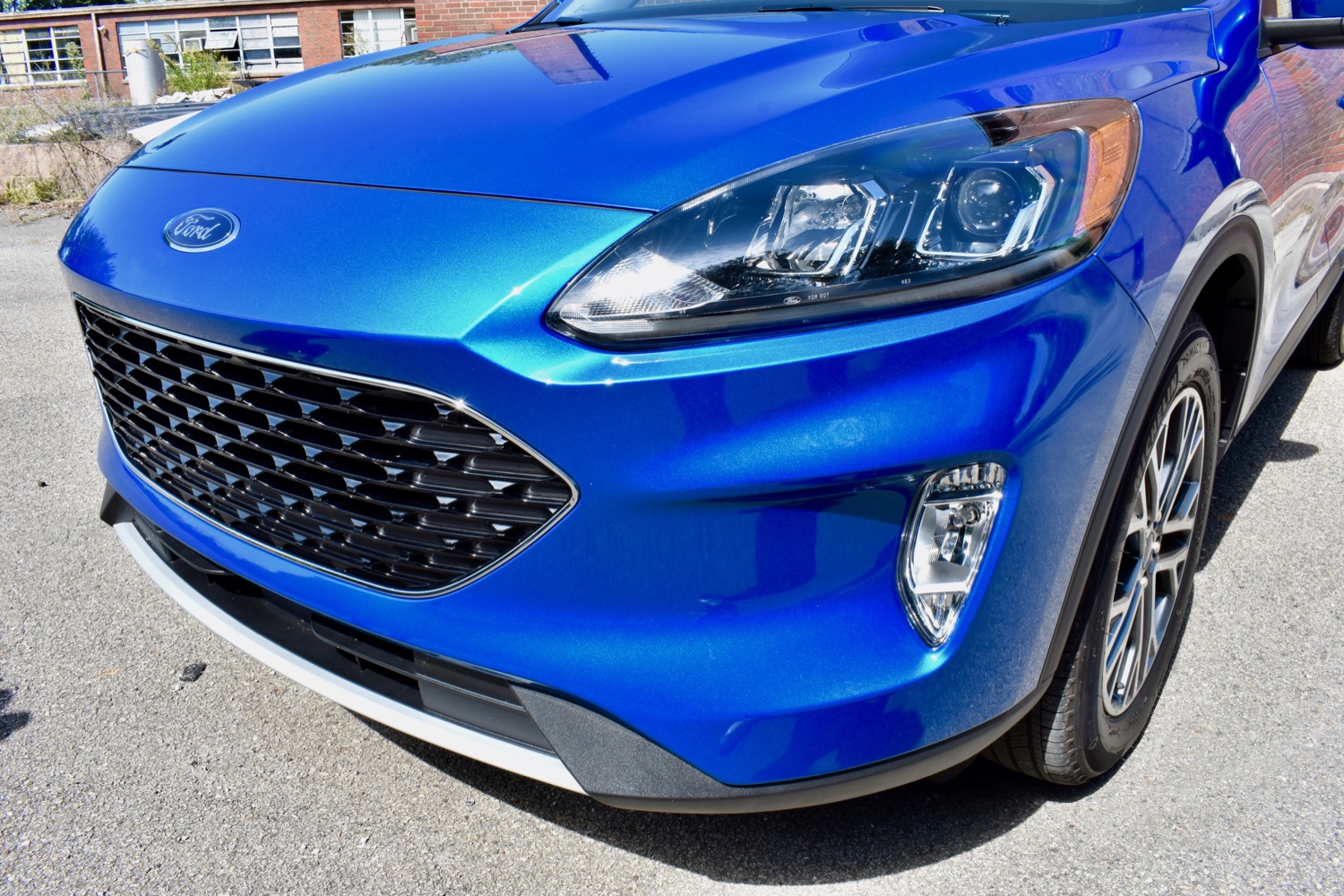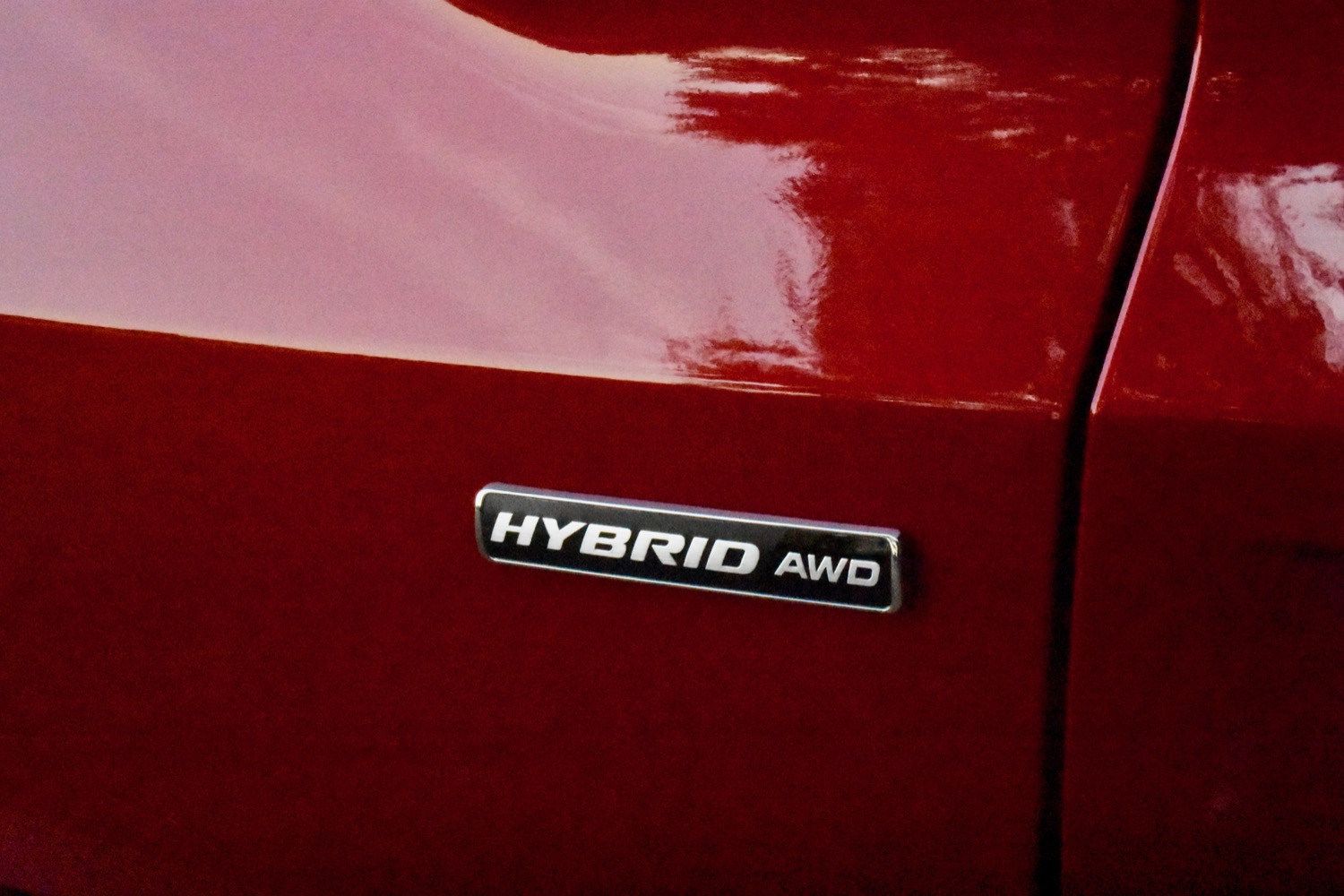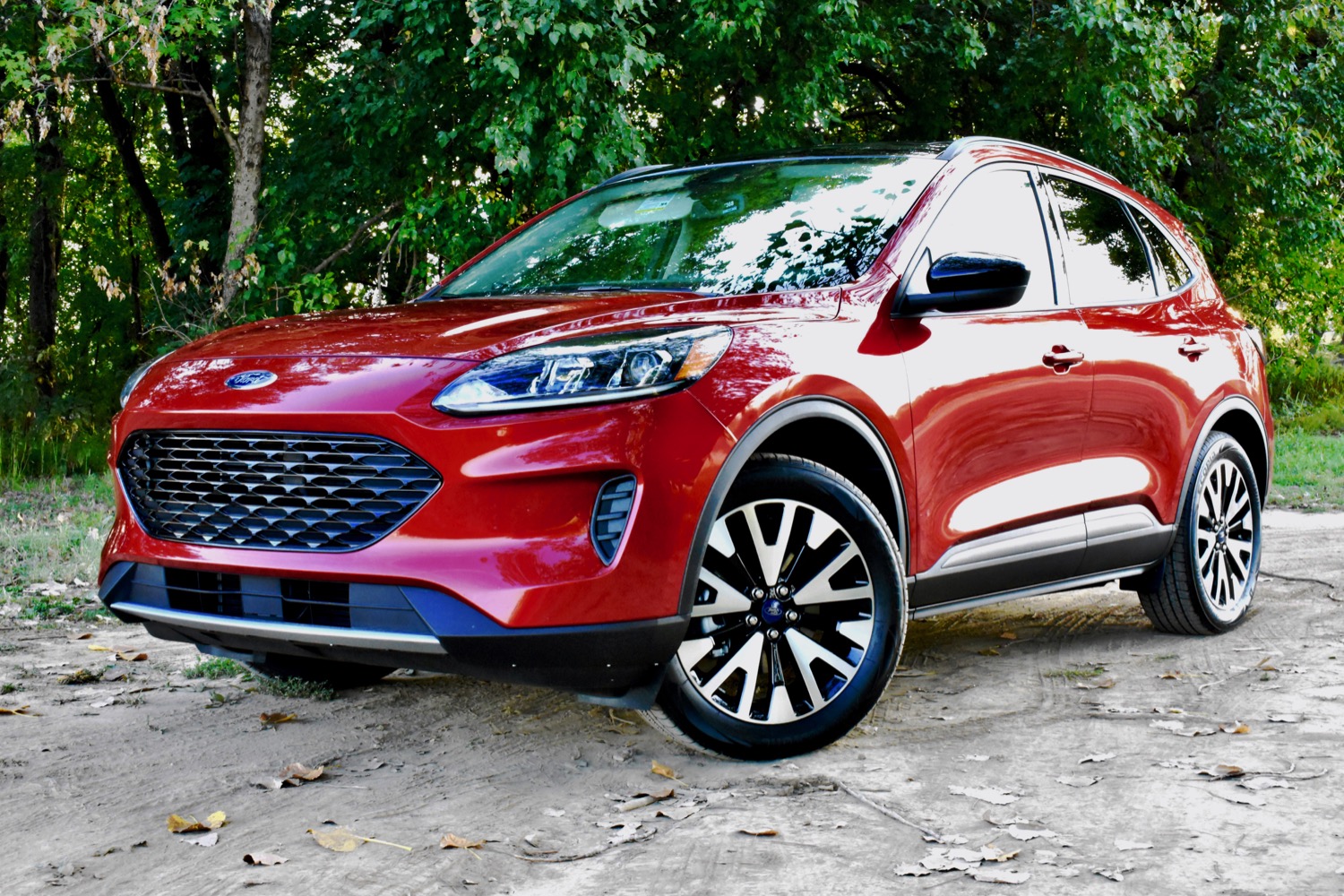
“The 2020 Ford Escape received an extensive overall, but that wasn't enough to make it leader of the pack.”
- Spacious interior
- Great powertrains
- Intuitive infotainment
- Sloppy handling
- Cheap interior materials
The original Ford Escape was one of the first compact crossovers, applying Ford’s experience with traditional SUVs like the Bronco and Explorer to what would become one of the hottest segments in the industry. The Escape has battled the Honda CR-V, Subaru Forester, and Toyota RAV4 for almost two decades, but now the crossover faces its biggest challenge yet.
Ford is eliminating all cars except the Mustang from its American lineup in favor of trucks and utility vehicles. In addition to competing with other compact crossovers, the 2020 Escape is also aimed at keeping current sedan and hatchback owners in the Ford fold.
To do that, Ford gave the 2020 Escape a more car-like appearance, updated its tech, and brought back the hybrid powertrain that hasn’t been seen in the Escape lineup since 2012. To find out if that was enough, Digital Trends traveled to Louisville, Kentucky, to drive the new Escape a stone’s throw from the factory that builds it. We tested SE ($28,985 as tested), SE Sport Hybrid ($30,240), SEL ($36,025), and Titanium ($39,475) models, covering every trim level except the base S.
Escape room
The compact crossover segment is a lot more crowded than it was when the first-generation Escape made its debut for the 2001 model year, or even when the outgoing-generation Escape arrived for the 2013 model year. To stand out from the crowd, Ford took the 2020 Escape’s exterior styling in a different direction than either of the previous generations.
The Escape has always tried to pretend to be a traditional, truck-based SUV, rather than the car-based crossover it actually is. With the 2020 model, Ford is done pretending. The new Escape adopts a sleek look, with a pointy nose and sloping roofline. It’s a stark contrast to the Subaru Forester and Toyota RAV4, which are still going for stereotypical boxiness, and puts the Escape more in line with the Mazda CX-5 and Kia Sportage. If Ford wants to win over sedan owners, that’s a smart move.
Ford made some important changes under the skin as well. The automaker claims to have reduced weight by an average of 200 pounds. Cutting pounds improves everything from acceleration to fuel economy, so that’s definitely a good thing. Instead of going with an all-aluminum body, as with the F-150 pickup truck, Ford used multiple metals. The hood and some suspension components are aluminum, but everything else is a mix of different steel grades.

That approach has a side benefit. The use of high-strength boron steel in the roof pillars means those pillars can be thinner without compromising crash safety, Jim Hughes, global chief engineer for the Escape, told Digital Trends. The thinner pillars reduce blind spots, Hughes noted. Thick roof pillars, which are typically required to pass crash tests, are indeed a bane of modern cars. We felt the Escape’s thinner pillars made a difference in visibility, but your results may vary depending on your height. We also felt that the Escape’s long hood and the steep rake of the windshield compromised forward visibility somewhat.
A sleek design usually compromises interior space, but we didn’t have any issues with the Escape. We found ample headroom and legroom – even in the back. Up front, the feeling of spaciousness was partly down to the truck-like dashboard, which doesn’t intrude on your personal space. In the back, the Escape is available with a sliding rear seat that can free up more cargo space, or passenger legroom, depending on what’s needed. The Nissan Rogue is the only other vehicle in this segment with that feature.
Not everything about the interior was great, though. Every trim level we looked at had too much unappealing-looking plastic, including door cards with a bizarre pockmarked texture on our SEL tester. The Honda CR-V and Volkswagen Tiguan also offer more cargo space, while the Subaru Forester has substantially more overall passenger space.
Room for tech, too
The tech changes aren’t as dramatic as the changes to the vehicle itself, but they do make a difference. The 2020 Escape still runs the Sync 3 infotainment system used in the previous-generation model, with an 8.0-inch touchscreen, Apple CarPlay/Android Auto compatibility, and a built-in Wi-Fi hot spot that can support up to 10 devices.
Sync 3 is one of the most intuitive systems on the market, and we appreciate Ford’s inclusion of analog controls for things like temperature and audio volume. The 2020 Escape is available with up to four USB ports, and the glovebox can accommodate a laptop, Ford claims
New for 2020 is an optional 12.3-inch digital instrument cluster, which replaces traditional analog gauges with a reconfigurable display. It’s not as fancy as the version used in the 2020 Ford Explorer, but that’s to be expected given the Escape’s lower price point. A head-up display is available as well.
Also new for 2020 is a 10-speaker, 575-watt Bang and Olufsen audio system. This optional extra uses an externally coupled subwoofer, which Ford claims is smaller and lighter than a conventional sub. We didn’t detect any issues with audio quality, which seemed comparable to the top-level audio systems in competitor vehicles.
Doing more with less
Ford led the trend in engine downsizing with its turbocharged EcoBoost engines, which aimed to maintain power while shrinking displacement, all in the name of fuel economy. But Ford is taking the concept to a new level with the 2020 Escape.
Can you imagine a crossover with room for five people, and their stuff, powered by a three-cylinder engine? That’s what you get with the 2020 Escape. Displacing just 1.5 liters, but sporting a turbocharger, the base engine makes a respectable 181 horsepower and 190 pound-feet of torque. That’s just 3 hp less than the naturally-aspirated 2.4-liter four-cylinder engine you get in a base Honda CR-V, and just 1 hp less than the Subaru Forester’s naturally aspirated 2.5-liter boxer-four. While our drive time in an Escape SE equipped with the 1.5-liter engine was brief, we weren’t left asking for more power. Even with the tiny engine, acceleration felt peppy.
It may look like a car, but the Escape handles like a truck.
We didn’t even miss the 2o20’s Escape’s optional 2.0-liter, turbocharged, four-cylinder engine, which makes 250 hp and 280 lb-ft. That’s a lot more power than the 190 hp the CR-V makes with its optional 1.5-liter turbo-four. But the Ford is no match for the Jeep Cherokee and its 2.0-liter turbo-four, which makes 270 hp (Jeep offers a V6 engine as well).
Still, the Escape’s 250 hp is plenty for a vehicle of this size, and we were impressed by how refined both the engine and the vehicle itself were. The only noise we could hear was a whistle from the turbocharger, which made it sound like there was a ghost under the hood.
It’s too bad the rest of the Escape couldn’t measure up to these two gasoline engines. It may look like a car, and share its basic platform with one, but the Escape handles like a truck. The suspension provides a smooth ride on straightaways, but on corners it’s completely overwhelmed.
The Escape may be 200 pounds lighter, but you wouldn’t know it based on how the suspension is tuned. Combine that with lifeless steering, and the driver simply has no idea what the car is doing. We don’t expect a crossover to handle like a sports car, but given the weight reduction, we did have higher expectations for the Escape.
Hybrid power
The 1.5-liter engine returns decent gas mileage, at 30 mpg combined (27 mpg city, 33 mpg highway) with front-wheel drive, and 28 mpg combined (26 mpg city, 31 mpg highway) with all-wheel drive. The 2.0-liter engine, which is only available with all-wheel drive, returns 26 mpg combined (23 mpg city, 31 mpg highway). But if fuel economy is the priority, Ford has other options.
A hybrid powertrain returns for the first time since 2012. Ford offered one on the first-generation Escape, but ditched it for the second-generation model (apparently the hybrid proved more popular with taxi drivers than retail buyers). Ford will also offer an Escape plug-in hybrid for the first time, although that model won’t be available at launch.
The hybrid powertrain combines a 2.5-liter Atkinson-cycle four-cylinder engine with electric assist, for a total system output of 200 hp. The plug-in hybrid model uses the same basic powertrain, but with a larger battery pack. It’s rated at 209 hp, and Ford expects to achieve at least 30 miles of electric range. That would beat the 22-mile range of the Mitsubishi Outlander – the only other plug-in hybrid crossover in this price range.
Ford didn’t have a plug-in hybrid on hand for us to drive, but we were pleased with the SE Sport Hybrid model we did get to test. The powertrain is very responsive, and seamlessly switches between gasoline and electric power. The Escape is a bit down on power compared to the Toyota RAV4 Hybrid, which is rated at 219 hp, but we didn’t miss those 10 extra horses. The difference does show up in tow ratings, however. The Escape hybrid is rated to two 1,500 pounds, compared to 1,750 pounds for the Toyota.
We still don’t know how the Escape will compare to the RAV4 on gas mileage, but it needs to beat the Toyota’s 40 mpg combined. The RAV4 is only available with all-wheel drive, but Ford will also offer a front-wheel drive Escape hybrid. That could give Ford an advantage, as all-wheel drive usually comes with a penalty in fuel economy.
The practical stuff
The 2020 Escape gets the Ford Co-Pilot360 bundle of driver aids as standard equipment. Co-Pilot360 includes automatic high beams, blind spot monitoring, autonomous emergency braking, and post-collision braking. Adaptive cruise control is an optional extra, but it’s standard equipment on the Honda CR-V and Toyota RAV4. Ford does offer a lane-centering feature the Honda and Toyota don’t have, but the Nissan Rogue offers similar capability with its optional ProPilot Assist system. One feature the Escape has that the competition doesn’t is Active Park Assist 2.0, which can back the crossover into parallel or perpendicular spaces with virtually no intervention from the driver, Ford claims.
Ford offers a three-year, 36,000-mile, bumper-to-bumper warranty and a five-year, 60,000-mile powertrain warranty. That’s fairly good for this segment, but Hyundai and Kia offer longer coverage periods.
Because the Escape has been redesigned, it is difficult to predict future reliability. However, it’s worth noting that some first-generation Escape hybrids are still on the road as taxis. Ford recently bought back an Escape hybrid that did 400,000 miles as a New York City taxi, and claims the Big Apple refugee still has its original powertrain. So Ford can build a durable hybrid, when it wants to.
Crash-test ratings from the National Highway Traffic Safety Administration and Insurance Institute for Highway Safety aren’t available yet, owing to the 2020 Escape’s newness.
How DT would configure this car
We liked all three Escape powertrains we sampled, but we think the hybrid offers the best balance of power and fuel efficiency. The specific hybrid Escape we drove was an SE Sport model with the Premium package, and that’s how we would equip our ideal Escape. The SE Sport gets both the 8.0-inch touchscreen infotainment system and the 12.3-inch digital instrument cluster, while the Premium package adds adaptive cruise control, a power tailgate, remote start, panoramic roof, and 19-inch wheels. While we liked the sound from the 10-speaker Bang and Olufsen audio system, we don’t think it’s worth the extra money, as getting the system requires a step up to the Titanium trim level.
Summary
The 2020 Ford Escape aims to soften the blow of Ford’s car culling, but first it needs to prove that its better than the legions of other compact crossovers on sale today. It may not even be able to do that.
Given that this is the first redesign the Escape has received in seven years, we were expecting big things from the 2020 model. But while the new Escape has a lot going for it, including a spacious interior, well-engineered powertrains, and sensible tech, it’s no game-changer. Ford gave the Escape more car-like styling, but the Mazda CX-5 has been there, done that. The Honda CR-V has a nicer interior, and more standard driver-assist tech. Ford brought back the Escape hybrid, but it’s unclear if the Escape will be able to match the fuel economy of the Toyota RAV4.
The Escape is a good all-around vehicle that should meet most crossover buyers’ needs. Yet it doesn’t redefine the segment it helped create, and that’s what Ford needed to do in order to convince buyers to splurge for an Escape over a regular sedan or hatchback.
Should you get one?
Yes. Other compact crossovers may offer more in specific areas, but the 2020 Ford Escape is a good overall package.






